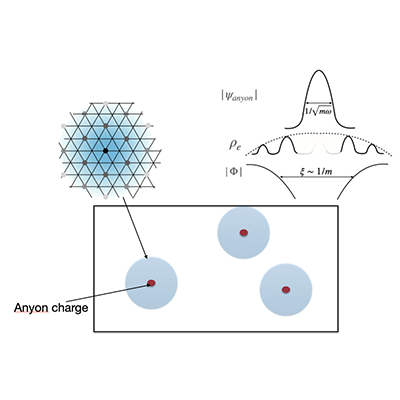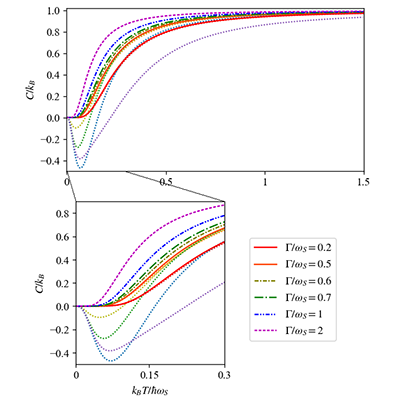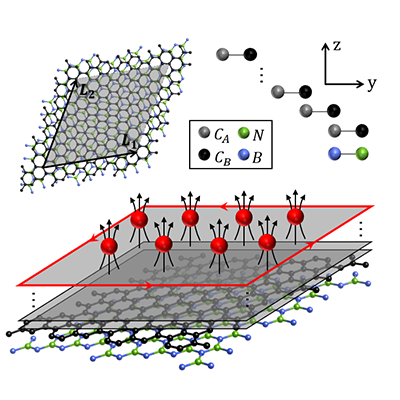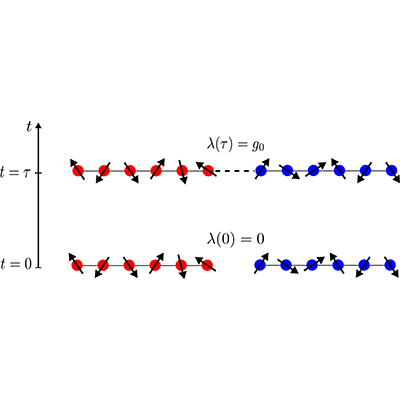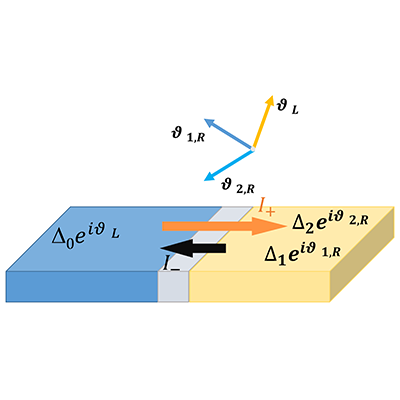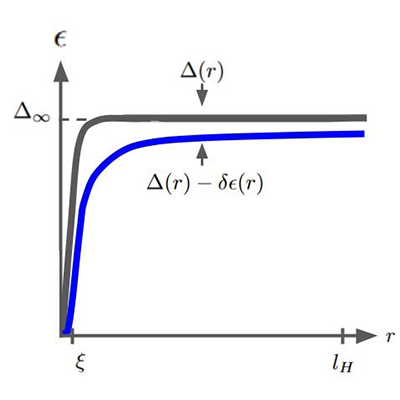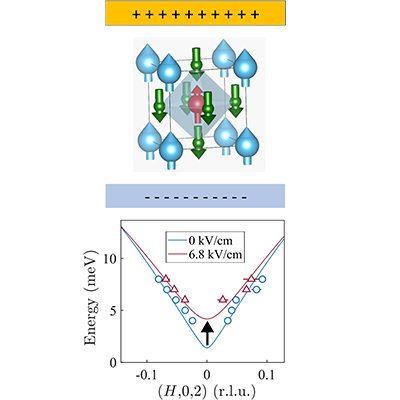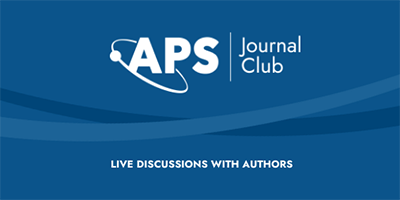EDITORS' SUGGESTION
Classical spin liquids (CSLs) can be classified by their lowest-energy flat bands. This work advances the classification scheme by integrating crystalline symmetry and topological quantum chemistry into it. The authors present here a mathematical framework to analyze the band representations of flat bands in CSLs, illuminating how symmetry protects different classes of CSLs. Concrete examples, such as the construction of a symmetry-protected pinch-line algebraic CSL, demonstrate the power of this new classification approach.
Yuan Fang, Jennifer Cano, Andriy H. Nevidomskyy, and Han Yan (闫寒)
Phys. Rev. B 110, 054421 (2024)
EDITORS' SUGGESTION
A new unconventional form of magnetism, called altermagnetism, was recently discovered, where a spin-split electronic band structure results in an anisotropic magnetization in momentum space, with a zero net magnetization. The authors show that when such altermagnetism meets superconductivity, a “Yoda ear” phase diagram appears, which hosts both finite-momentum superconductivity, even if the net magnetization is zero, and a rare field-induced superconducting region, in which a magnetic field induces superconductivity from a normal phase at zero field.
Debmalya Chakraborty and Annica M. Black-Schaffer
Phys. Rev. B 110, L060508 (2024)
EDITORS' SUGGESTION
Fractional quantum anomalous Hall (FQAH) states of matter with anyon excitations were discovered in 2023. Their intertwinement with a charge density wave (CDW) is captured by a recently developed quantum Ginzburg-Landau theory. This paper uses this theory to predict that localized anyons will nucleate particular spatial modulations of the electrical charge density, reflecting those in a proximate CDW phase. This phenomenon can be probed by scanning tunneling microscopy and be used to detect electron fractionalization.
Xue-Yang Song and T. Senthil
Phys. Rev. B 110, 085120 (2024)
EDITORS' SUGGESTION
Here, the authors predict theoretically the emergence of topological magnetism at the interface between the otherwise nonmagnetic B20 compounds FeSi and CoSi. Calculations using density functional theory and magnetic force theorem show that the chiral Dzyaloshinskii-Moriya interaction (DMI) in these B20 multilayers is significantly enhanced compared to bulk B20 compounds. The DMI also has a more complex structure here and stabilizes compact antiskyrmions, intermediate skyrmions, and AFM skyrmions, as confirmed by atomistic spin dynamics simulations.
Vladislav Borisov, Anna Delin, and Olle Eriksson
Phys. Rev. B 110, L060407 (2024)
EDITORS' SUGGESTION
Due to the favorable linear scaling with system size, irrespective of temperatures, finite-temperature orbital-free density functional theory (FT-OFDFT) holds considerable promise for investigating the properties of warm dense matter. However, the quality of FT-OFDFT strongly depends on a noninteracting free-energy-density functional. The authors derived a nonlocal free-energy functional named XWMF using line integrals. XWMF exhibits high numerical accuracy and stability, enabling FT-OFDFT for realistic simulations of the warm dense matter across a broad range of temperatures and pressures.
Cheng Ma et al.
Phys. Rev. B 110, 085113 (2024)
EDITORS' SUGGESTION
The strong system-reservoir coupling prevents the thermal equilibrium state of systems from being expressed as a Gibbs state with bare system Hamiltonian. Correspondingly, many thermodynamic quantities must be redefined. In particular, for the heat capacity of strongly coupled quantum Brownian motion, there has been controversy regarding inconsistencies in different definitions and the anomalous negative heat capacity. Here, the authors rigorously solve the reduced density matrix of quantum Brownian motion and obtain the renormalized Hamiltonian and reduced partition function. This resolves the controversy about the heat capacity under strong coupling.
Chuan-Zhe Yao and Wei-Min Zhang
Phys. Rev. B 110, 085114 (2024)
EDITORS' SUGGESTION
As the zero-field analogue of the fractional quantum Hall states, fractional Chern insulator states emerge from topologically nontrivial flat bands realized in lattice systems. Recently, a series of fractionally quantized Hall resistance plateaus have been observed in rhombohedral pentalayer graphene-hBN moiré superlattices under zero magnetic field, needing theoretical understanding. The authors have developed a theoretical workflow, discovering both integer and fractional Chern insulator states in rhombohedral multilayer graphene-hBN moiré superlattices, which are consistent with recent experimental results.
Zhongqing Guo, Xin Lu, Bo Xie, and Jianpeng Liu
Phys. Rev. B 110, 075109 (2024)
EDITORS' SUGGESTION
Scanning tunneling spectroscopy (STS) maps can be influenced by the so-called set point effect. This effect is often considered negligible, allowing various imaging modes to be used interchangeably without significant concern for subtle differences. However, this assumption may not always hold true. In this study, the authors examine how the inversion of STS imaging contrast of a charge density wave (CDW) varies across different imaging methods in 1-TiSe, a model CDW system with a CDW gap not centered at the Fermi level, which accentuates the set point effect. The findings reveal that only constant-height imaging enables a reliable detection of the charge density wave gap, effectively suppressing the additional contrast inversions observed with other methods.
Alessandro Scarfato et al.
Phys. Rev. B 110, 085109 (2024)
EDITORS' SUGGESTION
Nonequilibrium phenomena are commonly expected to be nonuniversal, i.e., they depend intricately on the system and processes. Here, the authors show that nevertheless some universal features do persist. They consider the energetic cost of finite-time nano-welding of quantum spin-½ chains. They find that some features depend only on (i) the process speed, (ii) the system’s symmetry, and (iii) the existence of an energy gap. Depending on the strength of SU(2) symmetry breaking, there are striking universalities in (a) the scaling of the cost with the duration time for slowly-varying processes and (b) the functional form of the cost-optimal protocol.
Moallison F. Cavalcante, Marcus V. S. Bonança, Eduardo Miranda, and Sebastian Deffner
Phys. Rev. B 110, 064304 (2024)
EDITORS' SUGGESTION
As the search for more compact data storage continues, crystallographic constraint of magnetic moments remains an important piece of the puzzle. Here, the authors explore these magnetic interactions in pyrrhotite (FeS), a magnetoelastic mineral that exhibits a nanoscale coupling between its ferroelastic and ferromagnetic domains. Careful quantification of the magnetic force microscopy imaging allows for a direct correlation between the bulk magnetic properties (as seen with magnetometry) and local micromagnetic structure, which reveals the ferroelastic twins beneath.
S. D. Seddon et al.
Phys. Rev. B 110, L060404 (2024)
EDITORS' SUGGESTION
Multiband superconductors with nontrivial interband phase relation between the order parameters can break time-reversal symmetry. The authors show here that a nonreciprocal supercurrent can arise in Josephson junctions linking conventional single-band and multiband superconductors with broken time-reversal symmetry, and the supercurrent rectification can be manipulated by the interband phase difference and the strength of the interband scattering. For a junction with three-band superconductors, the interband phase frustration leads to a hexagonal pattern of nodal lines in the profile of the rectification, where the amplitude drops to zero.
Yuriy Yerin et al.
Phys. Rev. B 110, 054501 (2024)
EDITORS' SUGGESTION
The authors develop here a theory of microwave absorption in superconductors in the presence of a pinned vortex lattice. They show that, in addition to the conventional absorption mechanism associated with the vortex core motion, there is another mechanism of microwave absorption caused by the time dependence of the quasiparticle density of states outside the vortex cores. This mechanism exists even in the absence of vortex motion, and provides the dominant contribution to microwave absorption in a broad range of parameters.
T. Liu, M. Smith, A. V. Andreev, and B. Z. Spivak
Phys. Rev. B 110, 064504 (2024)
EDITORS' SUGGESTION
If quasiperiodicity acts analogously to random disorder, then Anderson’s theorem for disordered superconductors indicates that unconventional (e.g., - or -wave) superconductivity will be suppressed in the presence of nonmagnetic impurities. Here, the authors find that unconventional superconductivity in a quasicrystal is suppressed only above a critical strength of the quasiperiodic potential. This suggests a qualitative distinction between quasiperiodic and disordered systems, with implications for our understanding of superconductivity in twisted moiré materials.
Nicole S. Ticea et al.
Phys. Rev. B 110, L060501 (2024)
EDITORS' SUGGESTION
SrTiO is a quantum paraelectric material that is in the vicinity of a paraelectric-to-ferroelectric phase transition. Therefore, the properties of SrTiO are strongly sensitive to external electric fields. In particular, the transverse optical (TO) phonon mode of SrTiO hardens significantly at the zone center upon the application of a moderate electric field. Here, the authors use neutron scattering to measure the dispersion of the TO mode in applied electric fields.
Henrik Jacobsen et al.
Phys. Rev. B 110, 054302 (2024)
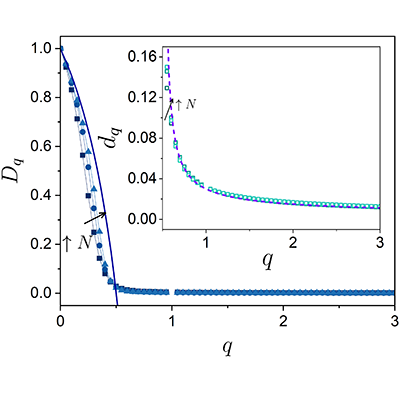
EDITORS' SUGGESTION
Power-law random banded matrix ensembles have proven effective in predicting critical properties at finite-dimensional Anderson transitions. Here, the authors extend the use of random matrices to infinite dimensions by introducing ensembles specifically designed to capture infinite-dimensional Anderson transitions. Using both analytical arguments and advanced numerical simulations, they uncover two unique critical behaviors: logarithmic multifractality and critical localization. As shown in the image, logarithmic multifractality displays an algebraic dependence of the large moments of wavefunction amplitudes on the logarithm of system size, characterized by a spectrum of log-multifractal dimensions , while the conventional multifractal dimensions , which describe scaling with system size, are zero. These insights provide a structured framework for understanding the pronounced finite-size effects and slow dynamics in these Anderson transitions, similar to the many-body localization transition.
Weitao Chen, Olivier Giraud, Jiangbin Gong, and Gabriel Lemarié
Phys. Rev. B 110, 014210 (2024)




